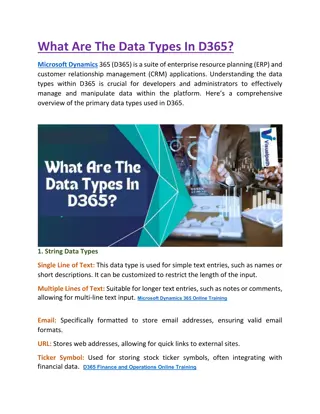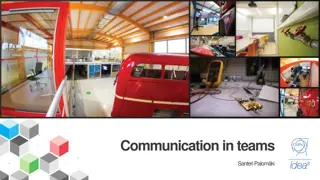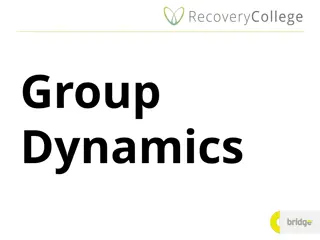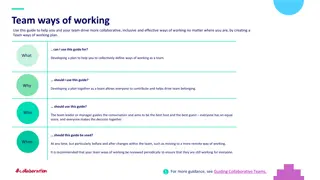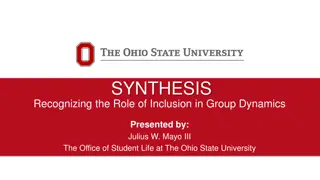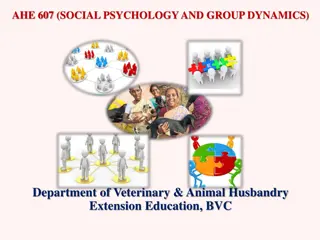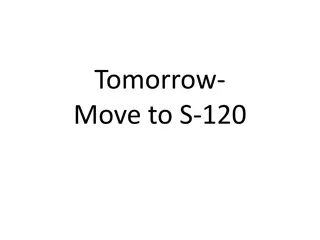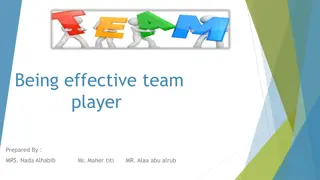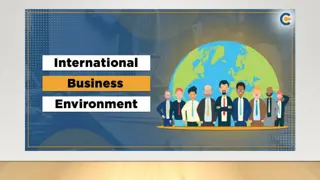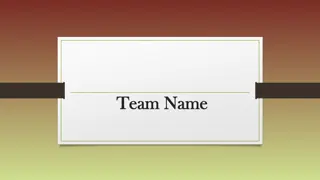Understanding Group Dynamics in Team Environments
Group norms play a crucial role in shaping behavior within a team setting, whether through prescribed norms taught to new members or emergent norms that develop through group interactions. Group roles like initiator, facilitator, and agitator also impact how a team functions. Effective initiators contribute positively to group energy, while negative initiator behavior can hinder group dynamics by dominating discussions and ignoring others' feelings.
Download Presentation

Please find below an Image/Link to download the presentation.
The content on the website is provided AS IS for your information and personal use only. It may not be sold, licensed, or shared on other websites without obtaining consent from the author. Download presentation by click this link. If you encounter any issues during the download, it is possible that the publisher has removed the file from their server.
E N D
Presentation Transcript
Chapter 11-1 David Cardenas, Lyssa Morman, Hannah Crain, Randai Cannon, Jacob Helms, Laura Woodfin, Rylee Smith
Identifying Group Norms Whether you join a group on your own or are assigned to one, you will be expected to follow the group norms. Group norms are informal, often unstated rules about what behavior is appropriate in a group. For example if you work as a stocker at a grocery store, you would have certain duties when you begin each workday or shift. You will be expected to punch a time clock, put on your uniform, and to check in with your supervisor to find any specific task that will be assigned to you that day. As you can see, the norms for one group may be very different from those for another group. Despite their differences, most groups norms can be either prescribed norms or emergent norms.
Prescribed Norms Prescribed Norm: rule for appropriate behavior that is routinely taught to new group members. written or unwritten examples: o in school: teachers give a list of rules for their class o in the workplace: offices: specific time of arrival, lunch, & departure armed forces: specific uniforms on different occasions sports: specific length of practice, specific uniforms for home/ away games, & how players should behave when traveling away
Emergent Norms Emergent Norms is any group that develops from the group interaction and mix of the group members personalities. A teacher assigns a group project
Group Roles In groups, members will have formal roles they are assigned. However, they have communication roles as well that indicate how they function in a group. three roles: initiator, facilitator, & agitator could switch roles in a single setting or play all three productive groups: members take turns playing roles which leads to a balanced group
Initiator An initiator in a group is the person who starts the group towards their goal(s). An effective initiator contributes positive energy to the group.
Positive Initiator Behavior Initiators can contribute negative energy to a group. Initiators who dominate a discussion also have a negative effect on a group. They may display negative behavior by ignoring the feelings of others while trying to get the task done.
Negative Initiator Behaviors Initiators also can contribute negative energy to a group. Initiators who dominate a discussion also have a negative effect on a group. They also may display negative behavior by ignoring the feelings of others while trying to get the task done.
Facilitator A person who also adds energy to the group by helping group members follow through on tasks.
Positive Facilitator Behaviors The Facilitator can contribute greatly to the effectiveness of a group or committee,team,and group. A effective facilitator is one who listens and cooperates. He/She can also support the members of the group, by doing extra research, making changes to a report, and help with anything else that is needed.
negative facilitator behaviors Like an initiator, facilitators can show negative behaviors. A common behavior would be assuming too much responsibility and delegating to others.A facilitator can also be concerned about keeping peace among the group. Conflict among a group can be beneficial, to cause the group members to examine the conflict closely.
Agitator Some parts of a group are known as negative or nonproductive, but a agitator is the one who gives the group a negative energy which will cause the group process to fail or slow down. Agitators inject negative energy into the group, There are six roles typically played by the Agitators, Nonparticipant, Distractor, Clown, Complainer, Critic and Absentee
Negative Agitator Behaviors Most agitator behaviors are negative, they work against the group s momentum and some may even work against the group's goals. Agitators can cause a lot of trouble for a group and start arguments.
Dealing with Negative Agitators Generally, when dealing with Agitators, the rule is to move on before the agitator has a chance to influence the group with their low energy. Once the group moved on the agitator s problem becomes one of their own, not of the group as a hole.
Positive Agitator behaviors Sometimes good for an agitator to slow down the momentum of the group. o example: If a group misses something important and the agitator points it out, the agitator has caused the group to see the mistake while the work is still in progress instead of after they had made the mistake. o example: If a committee is made to decide whether their employees should only get summer vacations and everyone quickly agrees, an agitator might challenge this with the idea of giving a winter vacation for the holidays. This allows the group to work together and actually discuss to find a solution and allows the people who were afraid to speak up an opportunity to.
Group Think Even though agitators cause disruptions, a group without them is just as bad. Group think is a term used to describe a group who has a strong desire to agree with each other. So strong in fact, that they make poor decisions.
Assuming Group Roles Although the roles of group members at first may seem very distinct, but to not be set in stone. In one point of a discussion, you may be an initiator trying to move the group discussions toward the goal. But later you may be a facilitator encouraging a silent member to participate. Also at another part of the discussion you may be an agitator, trying to get the group to consider another idea.The key to having successful group roles is balance
Analyzing Group Dynamics Group dynamics is the energy created as groups or members communicate and interact with each other, positive group interaction moves there group to there goal. While negative group interaction build barriers and are not able to reach there goal.
Group Discussion Have you ever been to a meeting that never gets down to business? Because you just see everyone having side conversations which cause the meeting to last twice as long. By using effective group discussion skills could have solved these problems
Impact of Norms on Dynamics In a group all the norms should contribute to leading the group to achieve their goal. They should also inject a sense of unity into the group. For Example, if a norm for committee members is to be courteous and direct with each other, members have a safe environment to voice their ideas. In other words, social norms should help, not distract.
Impact of Roles on Dynamics All members should be aware of what roles are needed in a setting. After a need has been decided, they should work together to fill the role. In order to be productive, groups need to have a good balance of all three roles: initiators, facilitators, and agitators. o Too many initiators can lead to a power struggle, while too few can send a meeting off track. o Too many facilitators can cause a group's work to stall, while too few can can cause less people to be heard. o Too many agitators can cause disruptions and disagreements, while too few can keep a group from fully examining their decisions.
Importance of Discussion During a meeting, it is important to hear information and opinions from all the group members. This can be accomplished through group discussion. Group discussion occurs when three of more people exchange ideas on a topic. While having a group discussion it is important to: Prepare ahead of time- This ensures that each member has something to add. Takes turns while speaking- If people talk over each other, it becomes counter productive. A facilitator can help make sure everyone gets a chance to speak. Listen carefully- Remember that everyone else took the time to prepare ahead of time too. They might have some information, or ideas that you had nt thought about. Allow them to finish before commenting.
Characteristics of Effective Discussions Maybe all of you have experience that not every discussion will go smoothly. Effective discussions in groups,committees,teams, and any other kind of groups share important qualities. interactive coopertive focused organized
Effective Group Discussion No one is born a discussion expert. But participating appropriately in a group discussion is a learned skill. to be the most effective in a committee, team, or other group discussion, you must learn how to adequately prepare for it. Preparing to participate in a group discussion involves some basic communication behaviors.
Become informed While working towards a goal, it is a good idea to become informed over the subject, instead of blindly striving after a goal.
Formulate Ideas Before your group meets take time to think about ideas you can contribute to the group's task. Use your reasoning skills to formulate ideas and questions about the topic. Think about how your ideas or proposals might affect different members of your group or other groups. Once you have considered all the factors, you can properly formulate and organize your ideas to present to your group
Prepare Materials After you are done with all your research and considering your topic, you will have to be prepared for your group to bring in new ideas. You will need materials that will help you and your group. For example you might need fact sheets,charts,or even graphs.





